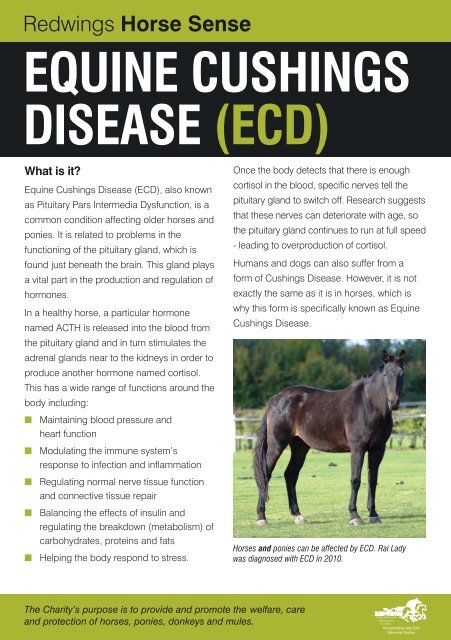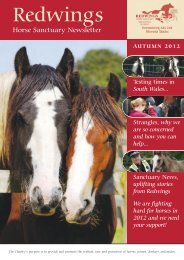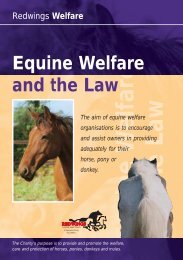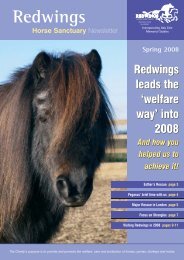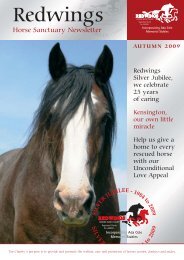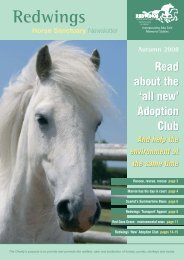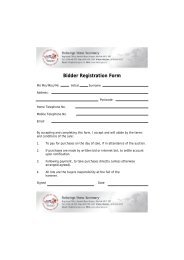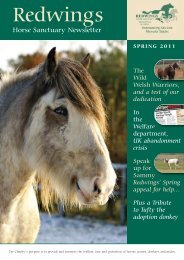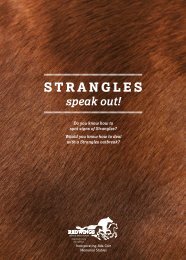Create successful ePaper yourself
Turn your PDF publications into a flip-book with our unique Google optimized e-Paper software.
<strong>Redwings</strong> Horse Sense<br />
<strong>EQUINE</strong> <strong>CUSHINGS</strong><br />
<strong>DISEASE</strong> (ECD)<br />
What is it<br />
Equine Cushings Disease (ECD), also known<br />
as Pituitary Pars Intermedia Dysfunction, is a<br />
common condition affecting older horses and<br />
ponies. It is related to problems in the<br />
functioning of the pituitary gland, which is<br />
found just beneath the brain. This gland plays<br />
a vital part in the production and regulation of<br />
hormones.<br />
In a healthy horse, a particular hormone<br />
named ACTH is released into the blood from<br />
the pituitary gland and in turn stimulates the<br />
adrenal glands near to the kidneys in order to<br />
produce another hormone named cortisol.<br />
This has a wide range of functions around the<br />
body including:<br />
■ Maintaining blood pressure and<br />
heart function<br />
■ Modulating the immune system’s<br />
response to infection and inflammation<br />
■ Regulating normal nerve tissue function<br />
and connective tissue repair<br />
■ Balancing the effects of insulin and<br />
regulating the breakdown (metabolism) of<br />
carbohydrates, proteins and fats<br />
■ Helping the body respond to stress.<br />
Once the body detects that there is enough<br />
cortisol in the blood, specific nerves tell the<br />
pituitary gland to switch off. Research suggests<br />
that these nerves can deteriorate with age, so<br />
the pituitary gland continues to run at full speed<br />
- leading to overproduction of cortisol.<br />
Humans and dogs can also suffer from a<br />
form of Cushings Disease. However, it is not<br />
exactly the same as it is in horses, which is<br />
why this form is specifically known as Equine<br />
Cushings Disease.<br />
Horses and ponies can be affected by ECD. Rai Lady<br />
was diagnosed with ECD in 2010.<br />
The Charity’s purpose is to provide and promote the welfare, care<br />
and protection of horses, ponies, donkeys and mules.
Equine Cushings Disease<br />
What are the signs<br />
The signs of ECD are the result of excess<br />
cortisol. They include one or more of the<br />
following:<br />
■ A thick, often curly coat, even in Summer<br />
(in the majority of cases, but not in all<br />
cases)<br />
■ Weight loss or muscle wastage<br />
■ Abnormal fat distribution, such as a pot<br />
belly or fatty pads around the eyes<br />
■ Susceptibility to laminitis<br />
■ Excessive drinking and urination<br />
■ Sweating, caused by the thick coat or the<br />
hormonal imbalance<br />
■ Recurring infections because of a less<br />
effective immune system, such as<br />
sinusitis, dermatitis, or conjunctivitis<br />
■ A sleepy demeanour.<br />
The early stages of ECD are subtle. It could<br />
be as simple as a delay in shedding of the<br />
Winter coat. Early stages could also include<br />
mild weight loss, or a single episode of<br />
laminitis. Weight loss and laminitis need<br />
prompt investigation and treatment, so<br />
consult a vet straight away.<br />
Vets can diagnose ECD through several routes.<br />
They can measure the levels of ACTH in the<br />
blood by running a blood test, or can challenge<br />
the body with steroids to test the functionality of<br />
the pituitary gland’s ‘switching off’ mechanism.<br />
In some cases, the horse’s appearance alone<br />
is enough for a vet to make a confident<br />
diagnosis without the need for tests.<br />
Treatment and Management<br />
ECD is a progressive disease that sadly<br />
cannot be cured. However, its symptoms can<br />
30-year-old Beauty has<br />
had her coat clipped to<br />
help her feel more<br />
comfortable.
Ben enjoyed a good quality of life for six years<br />
after being diagnosed with ECD.<br />
be successfully controlled through treatment<br />
and careful management, meaning ECD<br />
sufferers can enjoy a good quality of life for<br />
many years after diagnosis.<br />
There are several medications available to help<br />
manage hormone production, but only one is<br />
licensed and available through veterinary<br />
prescription. It contains pergolide, which tries<br />
to restore the balance of hormones in the body<br />
by mimicking the nerves that control the<br />
pituitary gland. The medication is in tablet form<br />
and is usually given once a day. This long-term<br />
treatment can be costly – but if the horse<br />
responds well, it is possible to reduce the daily<br />
dose over time. A vet will give specific advice<br />
on which medication is suitable based on the<br />
horse’s individual needs.<br />
Prevention of ECD symptoms should be<br />
factored in to the horse’s routine<br />
management. Clipping the long, thick coat –<br />
especially the underbelly and upper limbs –<br />
will ensure the horse feels cooler and<br />
more comfortable. Regular baths will be<br />
appreciated as they help with skin care (and<br />
eliminate odour from excess sweating!)<br />
Preventative health care is particularly<br />
important because of the horse’s poor<br />
immune system. Worming, farriery,<br />
dentistry and all vaccinations should be<br />
kept up-to-date. Even normally minor<br />
problems such as nasal discharge should<br />
be investigated as a matter of urgency. Be<br />
vigilant for any signs of upper respiratory<br />
tract disease and dermatitis – and bathe<br />
the eyes with warm water regularly to help<br />
prevent conjunctivitis.<br />
Regularly monitor the horse’s weight using a<br />
weigh tape. Although results from a weigh<br />
tape may not be completely accurate, weekly<br />
use will still help to gauge any relative weight<br />
loss or gain. Your vet can advise you on the<br />
right diet for your horse and if any<br />
supplements are needed.<br />
There is a delicate balance between<br />
maintaining the weight of horses with ECD<br />
and preventing episodes of laminitis. If the<br />
horse is prone to laminitis, make simple<br />
changes such as reducing or eliminating short<br />
feeds and replacing them with forage<br />
(preferably hay). However, if your horse has<br />
poor teeth and cannot cope with forage,<br />
consider chopped fibre feed or soaked high<br />
fibre cubes as the main part of its diet.<br />
Restrict access to rich grass by strip grazing or<br />
reducing turn-out time. Your vet may advise a<br />
supplement containing B vitamins and Vitamin<br />
C if grazing is particularly restricted, as these<br />
are helpful in supporting the immune system.
Equine Cushings Disease<br />
Always contact your vet at the first sign of<br />
laminitis. Treatment in its early phase means<br />
pain is resolved quickly and there will be less<br />
risk of long term changes within the hoof.<br />
problems. A salt lick or supplementary<br />
electrolytes may help horses that sweat<br />
excessively, as sweat contains many essential<br />
salts.<br />
Donkeys and Equine<br />
Cushings Disease<br />
An increase in drinking and urination is caused by the<br />
body’s need to flush out the excess cortisol.<br />
Availability of fresh and clean water is vital, as<br />
horses with ECD may drink over 80 litres a<br />
day. Also ensure that stabling has enough<br />
bedding to soak up the resulting amounts of<br />
urine! Soiled bedding must be removed every<br />
day to prevent breathing problems or hoof<br />
Donkeys can suffer from ECD as well as<br />
horses and ponies. They will display similar<br />
symptoms, but it can be more difficult to spot<br />
them. For example, donkeys have a<br />
permanently thick and hairy coat all year<br />
round! Knowing your donkey well and careful<br />
monitoring should be a natural part of their<br />
management and owners need to take note of<br />
even small unexplained differences in their<br />
physique or behaviour. Seeking veterinary<br />
advice sooner rather than later will help with<br />
the early diagnosis and treatment of<br />
conditions such as ECD.<br />
Call the <strong>Redwings</strong> Welfare Line for<br />
more information about Equine<br />
Cushings Disease on 01508 481008<br />
or email welfare@redwings.co.uk<br />
IN AN EMERGENCY SITUATION PLEASE CALL YOUR VET<br />
<strong>Redwings</strong> Welfare Team<br />
<strong>Redwings</strong> Horse Sanctuary, Hapton, Norwich NR15 1SP<br />
Tel: 01508 481008 (9am - 5pm, Monday to Friday)<br />
Email: info@redwings.co.uk<br />
<strong>Redwings</strong> Horse Sanctuary<br />
General Enquiries 01508 481000<br />
www.redwings.co.uk<br />
Registered Charity No.1068911<br />
R624/BP/11.11/5k


